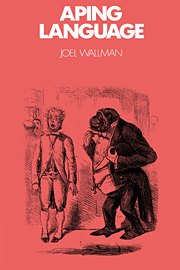9 - The chimpanzee and the Chinese room
Published online by Cambridge University Press: 03 November 2009
Summary
The argument about language in apes has a striking parallel in the debate among philosophers, psychologists, and computer scientists over the possibility of artificial intelligence. Much of the effort to create intelligent automata is justified by reference to an operational definition of machine intelligence proffered by Alan Turing some 40 years ago (1950). Turing asserted that the question of whether a machine can think is too imprecise and suggested that we assess the intelligence of a machine through an “imitation game.” The procedure he proposed was a bit more complex than the current conception of “the Turing test,” but the logic is unchanged. In this exercise, humans pose questions, on any subject, to either a person or a computer without knowing which. If the human interrogators are unable consistently to tell from the responses whether they are interacting with a person or the machine, then, according to Turing, we have the best evidence we could have for intelligence in a machine.
The most prominent critic of this behavioristic measure of intelligence is the philosopher John Searle (1980), who argues that simply because a machine is able to answer questions as a human would, it is not, ipso facto, engaging in thinking. Thought does not arise in a computer merely because it manipulates symbols; these symbols are devoid of meaning for the computer. Imagine, Searle bids in a now well-known thought experiment, a person ignorant of the Chinese language who is placed inside a room equipped with baskets of Chinese characters. He is also provided with a book of instructions for constructing sequences of characters (identified by shape) in response to sequences presented to him.
- Type
- Chapter
- Information
- Aping Language , pp. 149 - 153Publisher: Cambridge University PressPrint publication year: 1992



